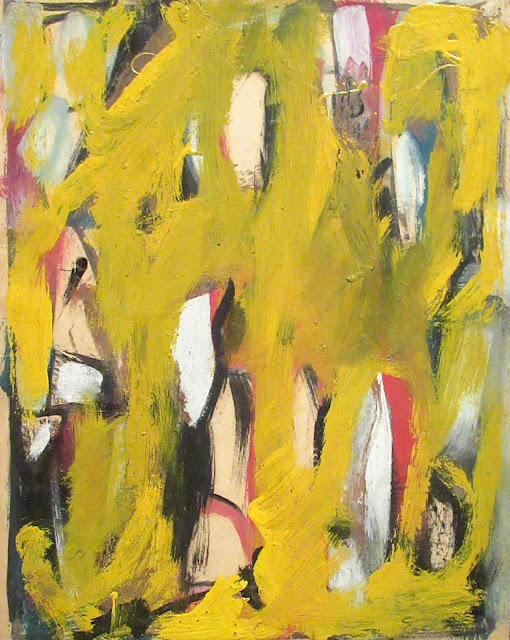Action, Gesture and Paint: Women Artists and Global Abstraction, 1940-70 at the Whitechapel Gallery.
An exhibition celebrating the women artists of mid-20th century gestural abstraction, showing how they shaped modern painting. The story of abstract art took a radical turn in the 1940s. Fusing bodily, gestural and emotive expression with colour, mark-making and the materiality of paint, this new movement was termed (in the USA) as Abstract Expressionism. It is often thought to have been centred in New York, where it was defined mainly by the work of white male artists. However, this new style of painting was a global phenomenon, shaped as much by local cultural and political context as by inernational exchange and dialogue.
The contributions of women have long been marginalised in modern art. The paintings presented here demonstrate how women across the world were fundamental in evolving the story of abstraction, incorporating experiences of turbulent social change into their work and promoting freedom of expression. Their art was made in a period of great historical shifts: the aftermath of WWII, global industrialisation, the rise of civil rights and post-colonial movements and a 'cold war' - marked by the threat of nuclear extinction - between capitalist democracies and communist states. Against this backdrop, the USA promoted abstract art as a form of western propaganda, to counter the influence of communism.
The exhibiton explores how artists made the canvas an arena for experimentation and personal expression through form and colour. It focuses on five themes: paint as material and process; symbolic languages drawn from myth and ritual; abstraction as an expression of the self; painting as movement and dance; and the canvas as environment.
The exhibition was divided into five sections and I have replicated this with my posts. There are five posts which mirror the secions of the exhibition, each with the same introduction.
Section 4: Performance, Gesture, Rhythm
Also described as 'Action Art', the paintings here are conceived as events. Often painted at the scale of the human body and made through physical movements such as throwing, jabbing, jumping and dancing, gestures that are mirrored with tonalities and shapes that balance, swoop or collide. Many of the artists here were influenced by modern dance and its rejection of traditional forms of ballet for the embrace of physical freedom - in particular for women. There is an exhilaration of pure abandonment as painting becomes performance, and the body and the canvas become one in a synthesis of physical and psychic energy.
Tomie Ohtake, Untitled, 1961, (oil on canvas)
Judith Godwin, USA, Black Pagoda, 1958-59, (oil on canvas)
Godwin was inspired by Hans Hofmann and modern choreographer Martha Graham. Through her studies with Hofmann, her long association with Graham, her expressive dance movements, her participation in the burgeoning of Abstract Expressionism and her love for Zen Buddhism, Godwin forged a unique artistic vocabulary of open, gestural strokes often featuring chevron, spirals and other forms that she dynamically interwove into complex relationships between figure and ground.
Miriam Schapiro, Canada/USA, Idyll II, 1956, (oil on canvas)
Schapiro was a painter, sculptor, printmaker and pioneer of feminist art. In the 1950s she created a substantial body of work in a gestural language that involved thinning her paint with turpentime before spreading it across the canvas in broad wipes. Although these works were abstract, Schapiro based them on works by old masters, specifically referencing male artists and recreating their works in her own style so as to position herself on an equal playing field as her forebears.
Elaine de Kooning, USA, The Bull, 1959 (acrylic and collage on Masonite)
A key figure in the New York School of the 1940s and 50s, de Kooning was aware of the sex inequality of her time, so chose to sign her artworks, EDK, to avoid her paintings 'being labelled as feminine in a traditionally masculine movement' as well as to distinguish her work from her husband, Willem de Kooning. Though mainly working in abstraction, she retained an interest in figuration, bringing the expressive gesture of Abstract Expressionism to bear on figurative subjects such as bullfights and portraits of friends and family.
Elaine de Kooning, , Untitled, 1950 (oil on paper on canvas)






Wonderful. I'm returning to London in a few weeks, and hope to visit this exhibition in time. The Schapiro canvass is really very alluring with depth. :)
ReplyDeleteGlad you liked the paintings Liam. I really enjoyed the exhibition and stayed there for ages. Unfortunately, this exhibition is over but I am sure you will find loads of other stuff to see.
DeleteI wanted to see Anselm Kiefer at the White Cube in Bermondsey but unfortunately did not make it to London before leaving for Greece - I will be here for three months, so have missed my chance.